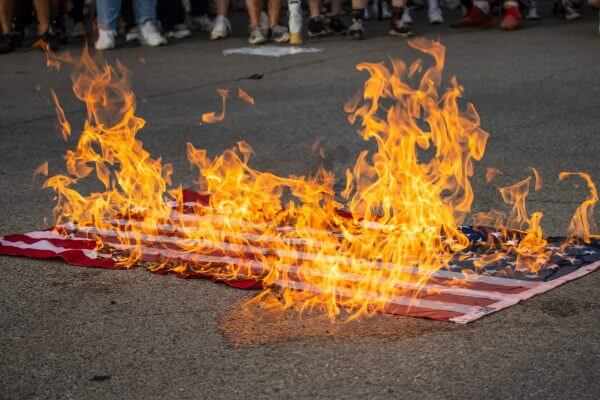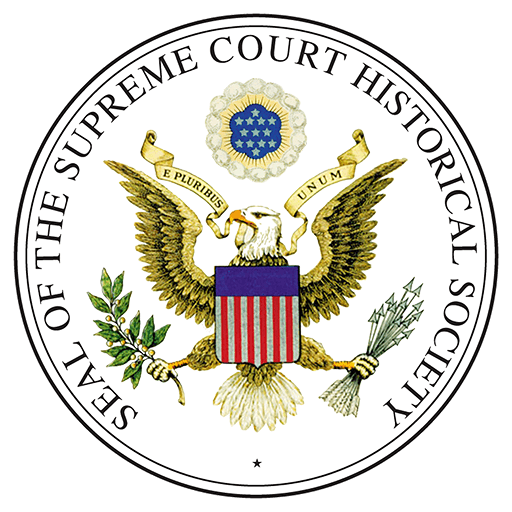
Tinker v. Des Moines (1969)
Students Have Free Speech Rights in Public Schools
Mary Beth Tinker and her brother, John, display two black armbands that North High School suspended them for wearing the bands to mourn the Vietnam war dead, 1968.
Overview
John and Mary Beth Tinker and Christopher Eckhardt of Des Moines, Iowa, wore black armbands to their public school as a symbol of protest against American involvement in the Vietnam War. School authorities asked the students to remove their armbands, and they were subsequently suspended. The Supreme Court decided that the students had the right to wear the armbands because they did not disrupt the educational mission of the school. Justice Abe Fortas stated that no one expects students to “shed their constitutional rights to freedom of speech or expression at the schoolhouse gate.”

Mary Beth Tinker and her brother, John, display two black armbands that North High School suspended them for wearing the bands to mourn the Vietnam war dead, 1968.
"In the absence of a specific showing of constitutionally valid reasons to regulate their speech, students are entitled to freedom of expression of their views . . . . It can hardly be argued that either students or teachers shed their constitutional rights to freedom of speech or expression at the schoolhouse gate."
- Justice Abe Fortas, speaking for the majority
Learning About Tinker v. Des Moines
Students
This section is for students. Use the links below to download classroom-ready .PDFs of case resources and activities.
About the Case
Full Case Summaries
A thorough summary of case facts, issues, relevant constitutional provisions/statutes/precedents, arguments for each side, decision, and case impact.
Case Background and Vocabulary
Important background information and related vocabulary terms.
Learning Activities
The Case
- What is Symbolic Speech? When Is It Protected?
- Classifying Arguments Activity (High School)
- Classifying Arguments Activity (Middle School – Regular Version)
- Classifying Arguments Activity (Middle School – Cut Out Strips Version)
- How Does a School Identify “Disruptive Speech?”
- Mini Moot Court Activity
- The Student Voice Editorial Staff Reacts
Teachers
Use the links below to access:
- student versions of the activities in .PDF and Word formats
- how to differentiate and adapt the materials
- how to scaffold the activities
- how to extend the activities
- technology suggestions
- answers to select activities
(Learn more about Street Law's commitment and approach to quality curriculum.)
About the Case
- Full Case Summaries: A summary of case facts, issues, relevant constitutional provisions/statutes/precedents, arguments for each side, decision, and impact. Available at high school and middle school levels.
- Case Background: Background information at three reading levels.
- Case Vocabulary: Important related vocabulary terms at two reading levels.
- Diagram of How the Case Moved Through the Court System
- Case Summary Graphic Organizer
- Case Summary Graphic Organizer - Fillable
- Decision: A summary of the decision and key excerpts from the opinion(s)
Learning Activities
After the Case
- Judicial Opinion Writing Activity: Morse v. Frederick (2007)
- Applying Precedents Activity: Hazelwood v. Kuhlmeier (1988)
- Applying Precedents Activity: Mahanoy v. B.L. (2021)
- Gangs, Tattoos, and Symbolic Speech
- The Internet, Schools, and Symbolic Speech: A Jigsaw Activity
- Deliberation Activity: Mahanoy v. B.L. (2021)
Teacher Resources
Planning Time and Activities
If you have ONE day...
- Read the background summary (•••, ••, •) and answer the questions.
- Complete the Classifying Arguments Activity. Discuss which arguments the students find most convincing. In middle school classrooms, complete Classifying Arguments Activity for Middle School or Classifying Arguments Activity for Middle School – Cut Out Strips.
- For homework, have students read the Key Excerpts from the Majority Opinion and Key Excerpts from the Dissenting Opinion and answer the questions. Follow up the next day by reviewing the questions with students.
If you have TWO days...
Note to teachers: We recommend that you invite a community resource person, such as a school administrator, judge, or lawyer, to assist in the activities described here for day two.
- Complete the activities for the first day (excluding homework).
- On the second day, complete the Mini Moot Court Activity -or-
- Alternatively, complete What is Symbolic Speech? When Is It Protected? and How Does a School Identify “Disruptive Speech?”
- For homework, have students read the Key Excerpts from the Majority Opinion and Key Excerpts from the Dissenting Opinion and answer the questions. Follow up the next day by reviewing the questions with students.
If you have THREE days...
- Complete the activities assigned for the first and second days (including homework).
- On the third day, complete Applying Precedents Activity: Hazelwood v. Kuhlmeier (1988)
- Complete Judicial Opinion Writing Activity: Morse v. Frederick (2007)
- For homework, have students complete Gangs, Tattoos, and Symbolic Speech.
If you have FOUR days...
Note to teachers: We recommend that you invite a community resource person, such as a school administrator, judge, or lawyer, to assist in the activities described here for day four.
- Complete the activities assigned for the first day, second and third days (excluding homework for day three).
- On the fourth day, complete the Gangs, Tattoos, and Symbolic Speech activity.
- Complete The Internet, Schools, and Symbolic Speech: A Jigsaw Activity.
Glossary
These are terms you will encounter during your study of Tinker v. Des Moines. View all Glossary terms here.
Related Cases
Legal Concepts
- These are legal concepts seen in Tinker v. Des Moines. Click a legal concept for an explanation and a list of other cases where it can be seen. View all Legal Concepts here.





